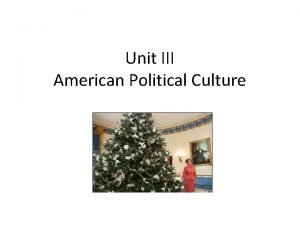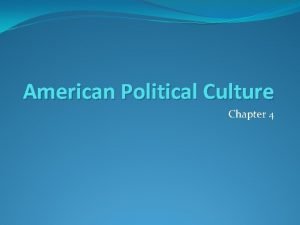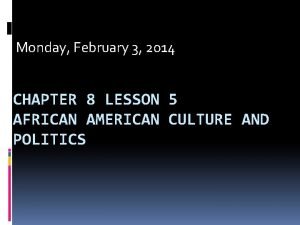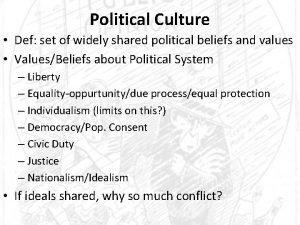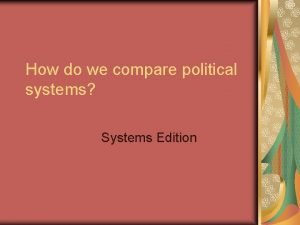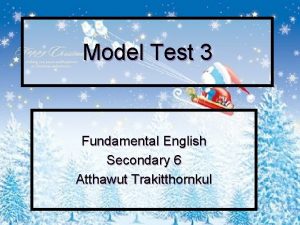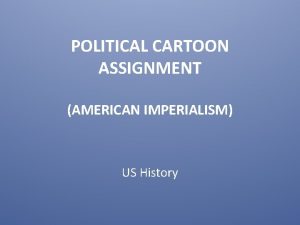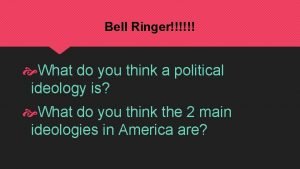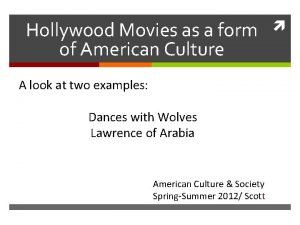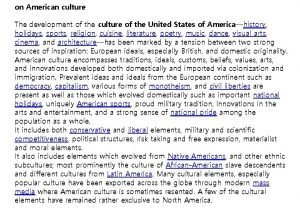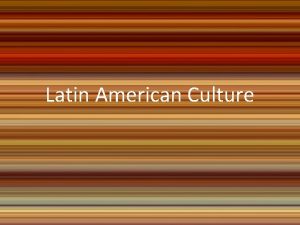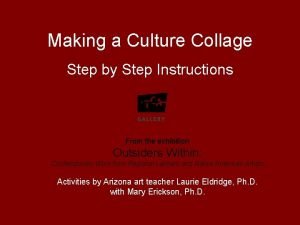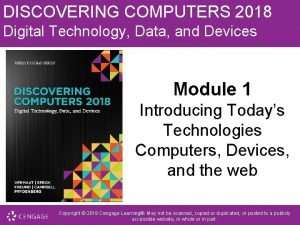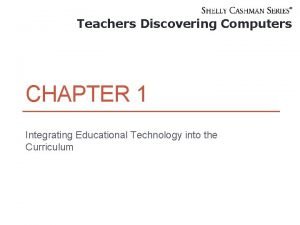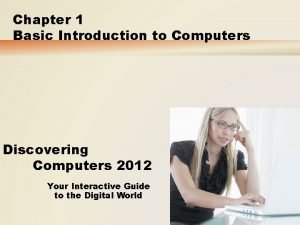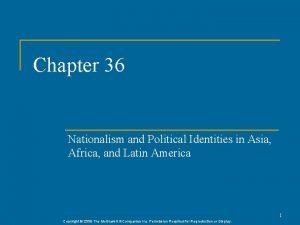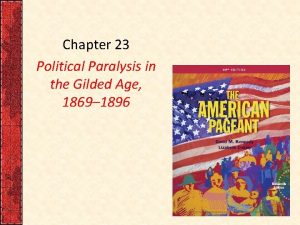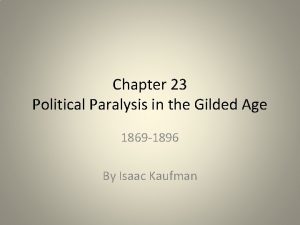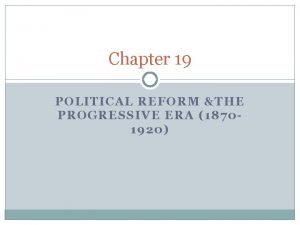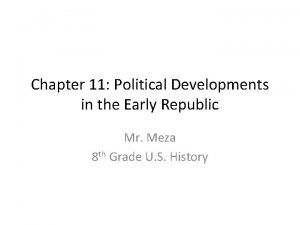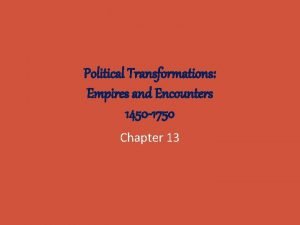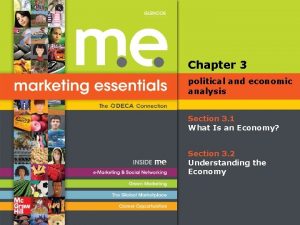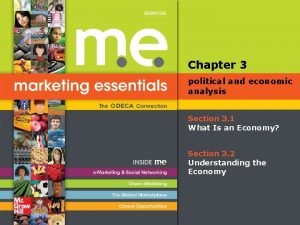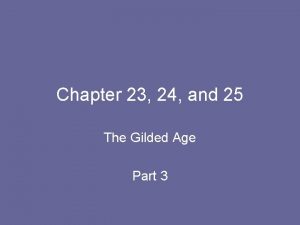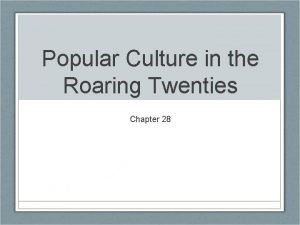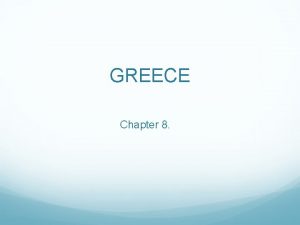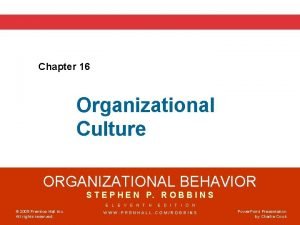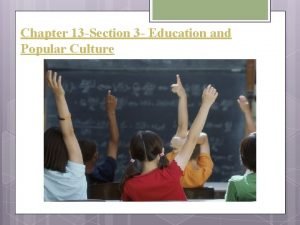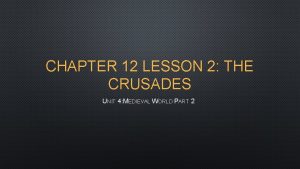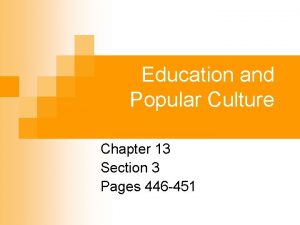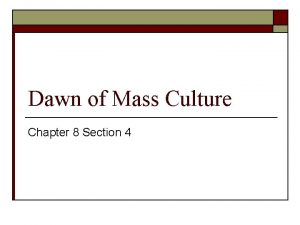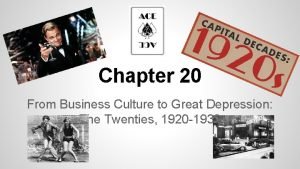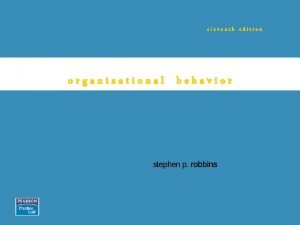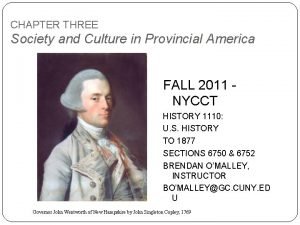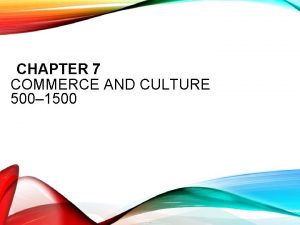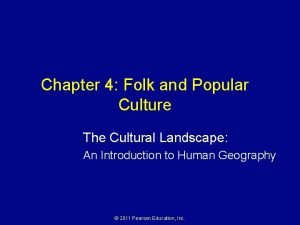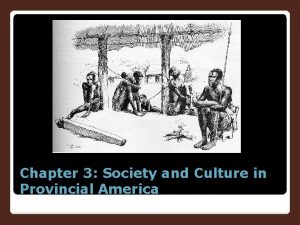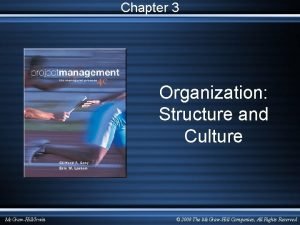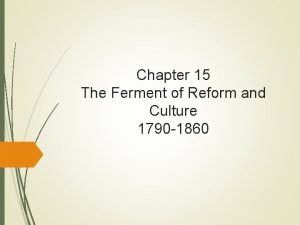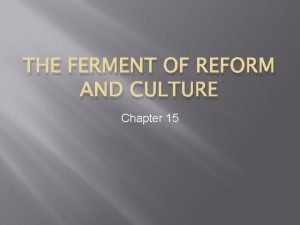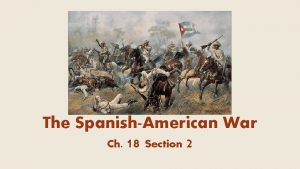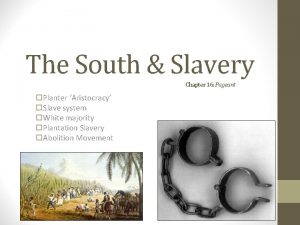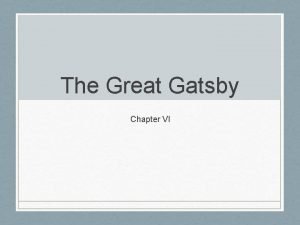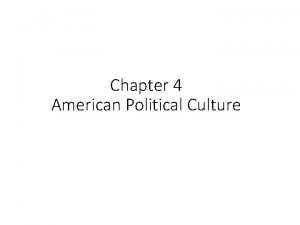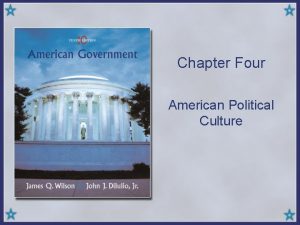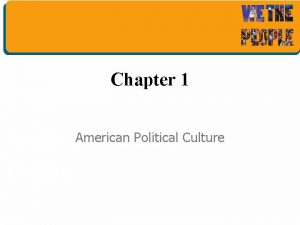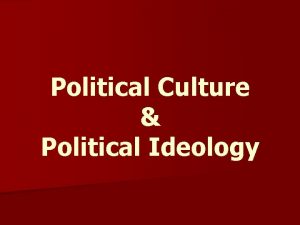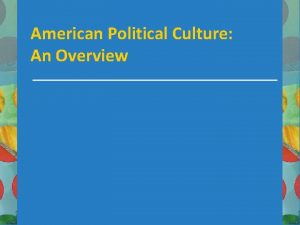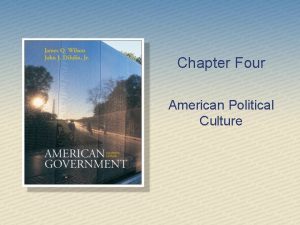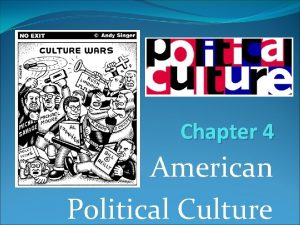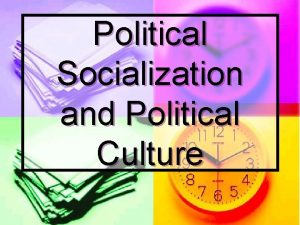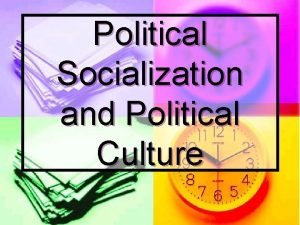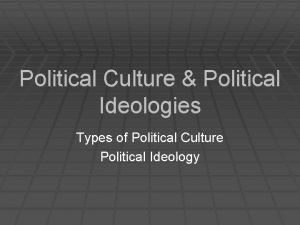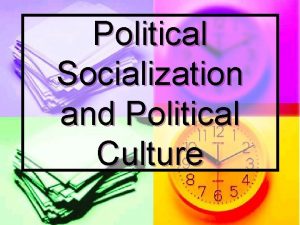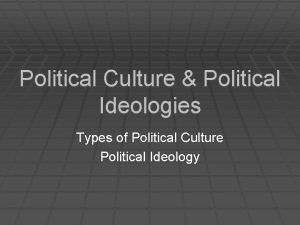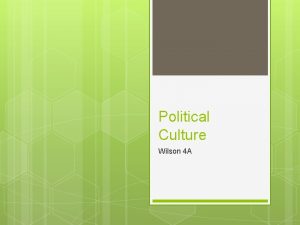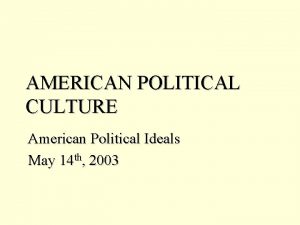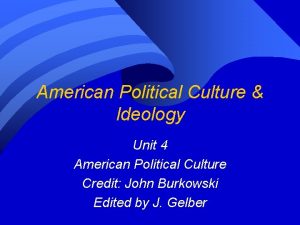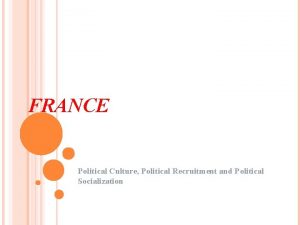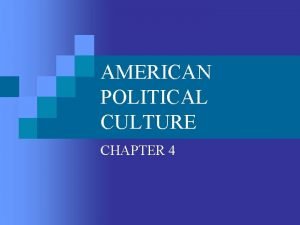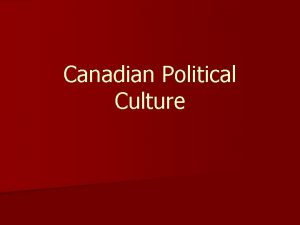CHAPTER 1 American Political Culture 2018 W W






































































- Slides: 70

CHAPTER 1 American Political Culture © 2018 W. W. Norton & Co. , Inc.

American Political Culture

Government Definitions Government • Refers to institutions and procedures through which a territory and its people are ruled Politics • Refers to conflict over the leadership, structure, and policies of governments

Is Government Needed? Americans have always harbored some suspicion of government; yet government is needed. A government is designed to provide “public goods. ” • Public goods: goods that benefit everyone but that no individual or group on its own can afford to supply • Examples include: • defense against foreign aggression • maintenance of public order • property rights and some measure of social justice

The Presence of Government in the Daily Life of a Student at “State University” TABLE 1. 1 The Presence of Government in the Daily Life of a Student at “State University” TIME OF DAY SCHEDULE 7: 00 A. M. Wake up. Standard time set by the national government. 7: 10 A. M. Shower. Water courtesy of local government, either a public entity or a regulated private company. Brush your teeth with toothpaste whose cavity-fighting claims have been verified by a federal agency. Dry your hair with an electric dryer manufactured according to federal government agency guidelines. 7: 30 A. M. Have a bowl of cereal with milk for breakfast. “Nutrition Facts” on food labels are a federal requirement, pasteurization of milk required by state law, freshness dating on milk based on state and federal standards, recycling the empty cereal box and milk carton enabled by state or local laws. 8: 30 A. M. Drive or take public transportation to campus. Air bags and seat belts required by federal and state laws. Roads and bridges paid for by state and local governments, speed and traffic laws set by state and local governments, public transportation subsidized by all levels of government. 8: 45 A. M. Arrive on campus of large public university. Buildings are 70 percent financed by state taxpayers. 9: 00 A. M. First class: Chemistry 101. Tuition partially paid by a federal loan (more than half the cost of university instruction is paid for by taxpayers), chemistry lab paid for with grants from the National Science Foundation (a federal agency) and smaller grants from business corporations made possible by federal income tax deductions for charitable contributions. Noon Eat lunch. College cafeteria financed by state dormitory authority on land grant from federal Department of Agriculture. 12: 47 P. M. Felt an earthquake! Check the U. S. Geological Survey at www. usgs. gov to see that it was a 3. 9 on the Richter scale. 2: 00 P. M. Second class: American Government 101 (your favorite class!). You may be taking this class because it is required by the state legislature or because it fulfills a university requirement. 4: 00 P. M. Third class: Computer Science 101. Free computers, software, and internet access courtesy of state subsidies plus grants and discounts from Apple and Microsoft, the costs of which are deducted from their corporate income taxes; internet built in part by federal government. Duplication of software prohibited by federal copyright laws. 6: 00 P. M. Eat dinner: hamburger and french fries. Meat inspected for bacteria by federal agencies. 7: 00 P. M. Work at part-time job at the campus library. Minimum wage set by federal, state, or local government; books and journals in library paid for by state taxpayers. 8: 15 P. M. Go online to check the status of your application for a federal student loan (FAFSA) on the Department of Education’s website at studentaid. ed. gov. 10: 00 P. M. Go home. Street lighting paid for by county and city governments, police patrols by city government. 10: 15 P. M. Watch TV. Networks regulated by federal government, cable public-access channels required by city law. Weather forecast provided to broadcasters by a federal agency. 10: 45 P. M. To complete your economics homework, visit the Bureau of Labor Statistics at www. bls. gov to look up unemployment levels since 1972. Midnight Put out the trash before going to bed. Trash collected by city sanitation department, financed by user charges.

Forms of Government: Structure, Size, and Operation Governments vary based on who governs. Autocracy: government by a single, nonelected individual (e. g. , a king, queen, or dictator) Oligarchy: government by a small group that is not accountable to citizens • Military officers, landowners, or wealthy merchants Democracy: a system of rule that permits citizens to play a significant part in the governmental process • Usually accomplished through the election of key public officials

Forms of Government: Limiting Governments also vary in how they govern. Constitutional government • Limited both in what it can do (substantive limits) and methods it can employ (procedural limits) Authoritarian government • Recognizes no limits on its authority, but is constrained by other institutions, such as business or a church Totalitarian government • Recognizes no limits on its authority and seeks to eliminate other institutions that might challenge it

Forms of Government

Limiting Government A key force behind limits on government power was the rise of the bourgeoisie. Bourgeoisie comes from bourgeois, which is the French word for “freeman of the city, ” or the middle class. • Embraced limits on government • Advanced principles of individual liberty • • freedom of speech freedom of assembly freedom of conscience freedom from arbitrary search and seizure

Access to Government: The Expansion of Participation Political participation expanded following two paths: • Through the Crown or aristocracy • Ironically, the aristocracy saw the common people as potential political allies against the bourgeoisie. • Through competing segments of the bourgeoisie • They all sought to gain political advantage by mobilizing the support of the working and lower classes.

Influencing the Government through Participation: Politics Political participation gradually spread, making politics increasingly relevant to all. Politics: conflict over leadership, structure, and policies of any organization to which people belong Politics also involves power. • Power is influence over a government’s leadership, organization, or policies.

Politics and Democracy In democracies, politics is shaped by how people are able to participate in the political process. Representative democracy (republic) • Government in which the populace selects representatives, who play a significant role in governmental decision-making Direct democracy • Rule that permits citizens to vote directly on laws and policies

Politics and Interest Groups and organized interests also participate in politics. Their political activities include: • Providing funds for candidates • Lobbying government officials • Trying to influence public opinion

Politics and Pluralism A pattern of struggles among interests is called group politics, or pluralism. • Pluralism: theory that all interests are, and should be, free to compete for influence in government This competition results in compromise and moderation.

Politics and Direct Action Politics can take place beyond formal channels. • Direct action is another form of political participation that includes: • violent action • nonviolent civil disobedience • Direct action can be a form of revolutionary politics that rejects the system entirely. • Peaceful direct action is protected by the Constitution.

Citizenship: Participation, Knowledge, and Efficacy Political knowledge is a key ingredient for political participation. Political knowledge: possessing information about the formal institutions of government, political actors, and political issues • Democracy functions best when citizens are informed.

Citizenship and Political Knowledge Citizenship derives from the Greek ideal: “enlightened political engagement. ” Political knowledge is more than having a few opinions. Political knowledge involves: • Knowing the rules and strategies that govern political institutions • Knowing the principles that govern institutions, especially in ways that relate to one’s own interests

Knowledge and Participation: Digital Citizenship The internet can facilitate the acquisition of political knowledge. Digital citizenship: refers to using the internet, social media, and other information technology to engage in society and government • Digital citizens are more likely to: • be interested in politics • discuss politics with friends, family, and coworkers

Americans’ Political Knowledge Most Americans know little about current issues or even the basics of how the government operates. In 2017, only about one-quarter percent of Americans could identify all three branches of the federal government. A little over one-half percent of Americans knew that Congress has the power to declare war. However, more than three-quarters knew that Congress has the power to raise taxes.

What Americans Know about Government TABLE 1. 2 What Americans Know about Government RESPONDENTS WHO PERCENTAGE Could identify all three branches of government 26 Knew Congress has the power to declare war 54 Knew Congress has the power to raise taxes 83 Knew Congress cannot establish an official religion of the United States Could not name any of the rights guaranteed by the First Amendment In 2016, could name the Republican vice-presidential candidate (Mike Pence). In 2016, could name the Democratic vice-presidential candidate (Tim Kaine) 77 37 37 22 SOURCES: Annenberg Constitution Day Civics Survey, July 14– 18, 2016, cdn. annenbergpublicpolicycenter. org/ wp-content/uploads/Constitution_Day_2016_Civics_Appendix. pdf; and Annenberg Constitution Day Civics Survey, August 9– 13, 2017, www. annenbergpublicpolicycenter. org/americans-are-poorly-informed-about-basic-constitutional -provisions/ (accessed 2/17/18).

Political Participation and Political Efficacy Political efficacy is another important ingredient in political participation. Political efficacy is the belief in the ability to influence what government does. • 1960 poll • One-quarter (25 percent) of respondents said elected officials did not care what citizens like themselves thought. • 2015 poll • Nearly three-quarters (74 percent) felt the same way.

Who Are Americans? Today’s Population and Immigration The United States has grown in population from 3. 9 million in 1790 to 327 million in 2018. With this growth has come increasing diversity. • In 1790, 81 percent of Americans could trace their roots to England northern Europe. • By 1900, an increasing number of Americans were from southern and eastern Europe. • After World War I, Congress limited immigration and established the National Origins quota system.






Who Are Americans? Immigration and Race U. S. citizenship The first census did not count Native Americans. • In fact, it was not until 1924 that Native Americans could become citizens. Most people of African descent were not officially made citizens until 1868. • The Fourteenth Amendment to the Constitution conferred citizenship on freed slaves.

Native Americans

Who Are Americans? Immigration and Race, Part 2 Historically, immigration policy has been biased against nonwhites. • Until 1870, only free whites could become naturalized citizens. • The Chinese Exclusion Act of 1882 outlawed the entry of Chinese laborers into the United States.

Immigrants Being Processed

Who Are Americans? The Twenty-First Century Our current population By 1965, Congress had lifted strict immigration limits. • This resulted in new waves of immigration from Asia and Latin America. • Current population (U. S. Census) • White: about 61 percent of the population • Asian: 5 percent • Black/African American: 13 percent • Latino/Hispanic: 18 percent

Who Are Americans? Continent of Origin

Twenty-First Century Americans

Who Are Americans? Immigration and Religion Immigration has diversified the nation by religion. Over three-quarters (80 percent) of the adult population was Protestant in 1900, compared to less than half (47 percent) today. Other religions • Catholics: 21 percent • Jews: 2 percent • Muslims: 1 percent A growing percentage of Americans report no church affiliation (23 percent).

Who Are Americans? Diversity’s Impact on Politics Age, geography, and the socioeconomic status of a population can impact politics. Different age groups have different needs for public services. Increasing numbers of Americans live in urban areas. • Issues of concern are often different than in rural areas. Economic inequality is on the rise, and the incomes of the middle class have largely stagnated.

American Political Culture Americans do not share a common bloodline or heritage, so what unites the nation? Political culture: broadly shared values, beliefs, and attitudes about how the government should function American political culture emphasizes the values of: • Liberty • Equality • Democracy

American Political Culture: Liberty No ideal is more central to American values than liberty. Liberty: freedom from government control • Personal freedom • Economic freedom Linked to concepts of limited government • Laissez-faire capitalism: free-market economic system with minimal or no government interference

American Political Culture: Equality The Declaration of Independence declares that “all men are created equal. ” Principles of equality include: • Equality of opportunity: the ideal that all people should have the freedom to use their talents to reach their fullest potential • Political equality: the right to participate in politics equally, based on the principle of “one person, one vote”

Equality and Public Opinion TABLE 1. 3 Equality and Public Opinion Americans believe in some forms of equality more than others. How do these survey results reflect disagreement about what equality means in practice? STATEMENT PERCENTAGE WHO AGREE It is very important that women have the same rights as men in our country. 91 Our society should do what is necessary to make sure that everyone has an equal opportunity to succeed. 86 Our country should have laws that protect gay, lesbian, bisexual, and transgender people against discrimination in jobs, public accommodations, and housing. 69 It should be legal for gay and lesbian couples to get married. 62 The fact that some are rich and some are poor is an acceptable part of the economic system. 52 Our country needs to continue making changes to give blacks equal rights with whites (according to whites). 54 Our country needs to continue making changes to give blacks equal rights with whites (according to blacks). 88 The country hasn’t gone far enough when it comes to gender equality (according to women). 57 The country hasn’t gone far enough when it comes to gender equality (according to men). 42 SOURCE: Pew Research Center, www. pewresearch. org/. See endnote 47 for specific reports.

The Fight for $15

American Political Culture: Democracy is also a major part of American political culture. In a democracy: • People choose their rulers and have some say over what those rulers do. • When political authority rests ultimately in the hands of the people, it is called popular sovereignty. • Government follows the preferences of the majority of voters, but protects the rights of the minority. • A democratic principle known as majority rule, minority rights

What Americans Think about Government Conservative in theory, liberal in practice Government in general • More Americans consider themselves politically conservative than liberal. • A majority of Americans said the federal government has too much power. However, specific government programs show support. • Overwhelming majorities want Social Security spending to be kept the same or increased.

What Americans Think about Government: Trust in government has been low in recent years. In the early 1960 s, three-fourths of Americans said they trusted government most of the time or always. Trust spiked after the September 11 terrorist attacks, but fell back to low, preattack levels within three years. In 2015, only 19 percent of Americans trusted the government.

Donald Trump

Importance of Trust to Government In the absence of trust, government cannot function effectively. The public may refuse to pay taxes for needed programs. Government may be unable to attract workers. It becomes more difficult to defend national interests. • Economy and national security may be jeopardized.

What Americans Think about Government: Level of Trust








Public Opinion Poll: Q 1 How much would you say the work and decisions of the federal government affect what happens in your life? a) b) c) d) e) not at all a little a moderate amount a lot a great deal

Public Opinion Poll: Q 2 Do you believe our government should do more, the same, or less for the citizens of our country? a) b) c) d) more the same less no opinion

Public Opinion Poll: Q 3 How much of the time do you think you can trust the federal government to do what is right and fair? a) b) c) d) just about always most of the time only some of the time never

Public Opinion Poll: Q 4 How much do you believe public officials care about what people like you think? a) b) c) d) e) a great deal a lot a moderate amount a little not at all

Public Opinion Poll: Q 5 How much do you believe people like you can affect what the government does? a) b) c) d) e) a great deal a lot a moderate amount a little not at all

Public Opinion Poll: Q 6 How interested are you in information about what is going on in government and politics? a) b) c) d) e) extremely interested very interested moderately interested slightly interested not interested at all

Public Opinion Poll: Q 7 How often do you pay attention to what is going on in government and politics? a) b) c) d) e) never once in a while about half the time most of the time all of the time

Additional Information Following this slide, you will find additional images, figures, and tables from the textbook.

Forms of Government: John Locke

Forms of Government: John Stuart Mill

Influencing the Government through Participation: Direct Action


Income in the United States

A Diverse America

American Political Culture: Patrick Henry

Federal Student Aid Website © 2018 W. W. Norton & Co. , Inc.
 American political culture definition
American political culture definition American political culture definition
American political culture definition American vs indian culture
American vs indian culture B a f c j e
B a f c j e Chapter 8 lesson 5 african american culture and politics
Chapter 8 lesson 5 african american culture and politics American academy of allergy asthma and immunology 2018
American academy of allergy asthma and immunology 2018 Political culture def
Political culture def Is texas in the bible belt
Is texas in the bible belt What is political culture
What is political culture If a ruby is heated it temporarily lose its color
If a ruby is heated it temporarily lose its color American imperialism political cartoons explained
American imperialism political cartoons explained American imperialism political cartoon
American imperialism political cartoon American political spectrum
American political spectrum Non material culture examples
Non material culture examples Sociologists define a symbol as
Sociologists define a symbol as Batch culture vs continuous culture
Batch culture vs continuous culture Fed-batch
Fed-batch Characteristics of collectivism
Characteristics of collectivism Stroke culture method
Stroke culture method Folk culture and popular culture venn diagram
Folk culture and popular culture venn diagram A sub-culture group
A sub-culture group Leisure
Leisure Urease test
Urease test Folk culture and popular culture venn diagram
Folk culture and popular culture venn diagram Inert organizational culture
Inert organizational culture Pour plate method
Pour plate method Lawn or carpet culture
Lawn or carpet culture Quality culture
Quality culture Surface culture deep culture and esol
Surface culture deep culture and esol Movies that represent american culture
Movies that represent american culture The development of an american culture
The development of an american culture American culture examples
American culture examples Cultural collage ideas
Cultural collage ideas Discovering computers 2018 ppt download
Discovering computers 2018 ppt download Discovering computers 2018 chapter 1
Discovering computers 2018 chapter 1 Discovering computers 2018 chapter 1
Discovering computers 2018 chapter 1 Chapter 35 nationalism and political identities in asia
Chapter 35 nationalism and political identities in asia Chapter 36 nationalism and political identities in asia
Chapter 36 nationalism and political identities in asia Chapter 23 political paralysis in the gilded age
Chapter 23 political paralysis in the gilded age Political paralysis in the gilded age
Political paralysis in the gilded age Chapter 19 political reform and the progressive era
Chapter 19 political reform and the progressive era Political developments in the early republic
Political developments in the early republic Chapter 5 political transformations empires and encounters
Chapter 5 political transformations empires and encounters Chapter 3 political and economic analysis
Chapter 3 political and economic analysis Chapter 3 political and economic analysis
Chapter 3 political and economic analysis Chapter 23 political paralysis in the gilded age
Chapter 23 political paralysis in the gilded age Chapter 28 popular culture in the roaring twenties
Chapter 28 popular culture in the roaring twenties Chapter 8 lesson 1 greek culture
Chapter 8 lesson 1 greek culture Chapter 8 human resources culture and diversity
Chapter 8 human resources culture and diversity Chapter 8 test human resources culture and diversity
Chapter 8 test human resources culture and diversity Chapter 16 organizational culture
Chapter 16 organizational culture Chapter 13 section 3 education and popular culture
Chapter 13 section 3 education and popular culture Chapter 12 lesson 2 the crusades answer key
Chapter 12 lesson 2 the crusades answer key Steamboat willie
Steamboat willie Dawn of mass culture
Dawn of mass culture Chapter 20 from business culture to great depression
Chapter 20 from business culture to great depression Chapter 19 section 1 postwar america
Chapter 19 section 1 postwar america Customer responsive organization
Customer responsive organization Chapter 3 society and culture in provincial america notes
Chapter 3 society and culture in provincial america notes Commerce and culture chapter 7
Commerce and culture chapter 7 Folk and popular culture
Folk and popular culture Chapter 4 folk and popular culture
Chapter 4 folk and popular culture Chapter 3 society and culture in provincial america
Chapter 3 society and culture in provincial america Chapter 3 organization structure and culture
Chapter 3 organization structure and culture Chapter 15 the ferment of reform and culture
Chapter 15 the ferment of reform and culture The ferment of reform and culture
The ferment of reform and culture Chapter 18 section 2 the spanish american war
Chapter 18 section 2 the spanish american war American pageant chapter 16
American pageant chapter 16 The american dream in chapter 6 of the great gatsby
The american dream in chapter 6 of the great gatsby The american pageant chapter 35
The american pageant chapter 35 Chapter 8 section 1 latin american peoples win independence
Chapter 8 section 1 latin american peoples win independence
